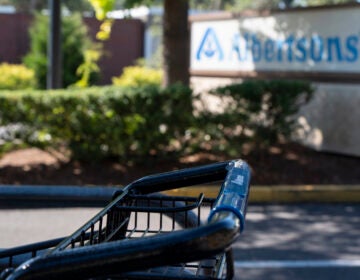Here are the 5 things to know about the state of the economy this Independence Day

Travelers wait in line at Hartsfield-Jackson Atlanta International Airport in Atlanta on June 30, 2023, ahead of the 4th of July holiday weekend. Consumers are traveling and eating out more though they are paring down spending in other ways. (Elijah Nouvelage/AFP via Getty Images)
As the nation celebrates its 247th birthday with hot dogs and fireworks, the U.S. economy is somewhere in between sizzling and fizzling.
The job market is strong, with unemployment near a half-century low. But inflation — and the Federal Reserve’s efforts to fight it — are keeping recession fears alive.
Here are five things to know about the economy during this Fourth of July holiday.
There’s good news and bad news about inflation
This time last summer, the U.S. was facing the highest inflation in four decades. Gasoline prices had hit an all-time high, topping $5 per gallon in the wake of Russia’s invasion of Ukraine, and the cost of a Fourth of July cookout was soaring.
Since then, inflation has moderated significantly, dropping to 4% in May from 9.1% last June. Gasoline prices have fallen to around $3.53 per gallon according to AAA. And grocery bills have dipped slightly in the last three months.
Stripping out volatile food and energy costs, however, so-called “core inflation” remains stubbornly high at 5.3% in May. That’s more than two and a half times the Federal Reserve’s target rate of 2%.
So while the price of many goods has leveled off or even fallen, the cost of services such as restaurant meals and car repair continues to climb.
The Fed is not done with its fight against inflation
The Fed’s concern over rising prices means policymakers are likely to push interest rates at least somewhat higher, in an effort to tamp down demand and bring inflation under control.
The Fed has already raised its benchmark rate ten times since March of last year, from near zero to just over 5%, marking the most aggressive actions to fight inflation since the early 1980s.
While Fed policymakers left interest rates unchanged at their last meeting in June, they hinted that one or two more quarter-point rate hikes are likely by the end of this year.
That should continue pushing up borrowing costs, making it more expensive to buy a house, finance a business or carry a balance on a credit card.
The job market is still humming along … for now
Although economists had warned the Fed’s higher interest rates could dampen the job market, it hasn’t turned out that way so far.
In fact, employers have added more than 4 million jobs in the last year, or an average of more than 338,000 jobs a month. The unemployment rate has been below 4% for 16 months in a row — the longest such stretch since the 1960s.
And the unemployment rate for African Americans hit an all-time low of 4.7% in April, before climbing slightly the following month.
Many industries such as health care and hospitality have continued to expand. And even those that are struggling are reluctant to lay off workers for fear it will be hard to hire them back when business rebounds.
There are some signs, however, that demand for workers is cooling. The pace of job growth in the last six months is slightly slower than in the previous six. Job openings have also declined, although there are still far more open positions than unemployed workers to fill them.
Employers are having to pay more to attract workers, although wage growth has slowed in the past year. Average private sector wages in May were 4.3% higher than a year ago, slightly outpacing inflation and boosting workers’ real buying power.
No, recession fears haven’t gone away
Despite fears the U.S. would skid into a recession this year, the economy has continued to grow, though at a slower pace than it was last fall.
The nation’s gross domestic product grew at an annual rate of 2% in the first three months of the year — down from 2.6% at the end of last year and 3.4% in the third quarter of 2022.
That doesn’t mean worries about a downturn have subsided, however. It’s still not clear if, or when, the economy might sink into a recession.
Rising interest rates have been a particular drag on industries such as housing and manufacturing, and the impact of the Fed’s aggressive actions will continue to filter through to the broader economy.
“Uncertainty right now is our biggest enemy,” says Tim Fiore who conducts a monthly survey of factory managers for the Institute for Supply Management.
Consumers are still spending but not as freely
What’s helping to keep the economy afloat is consumer spending, which accounts for more than two-thirds of all economic activity. But the consumer life-raft may be losing a little air.
Spending rose just one-tenth of one percent in May, a marked slowdown from the month before.
Rebecca Veverka, for example, has been pinching pennies in her entertainment and travel budget to avoid straining her bank account. The Parma, Ohio resident has canceled most of her TV streaming services and now subscribes to just one at a time. She’s also opted not to visit a friend in Washington state this summer.
“I’m in a place right now where I can buckle down and manage, but if it gets much worse, I’m not sure what more I can do to handle it,” Veverka says. She recently drew down some of her savings to pay off costly credit card debt.
Americans piled up savings in the early months of the pandemic when a lot of spending was off limits and the government was sending out relief payments.
Over the last year, those savings helped many people maintain their spending despite rising prices and interest rates. But economists at Wells Fargo say those “excess” savings may soon be whittled away.
“Whether the pandemic-related buffer runs dry by the end of this year or the start of next, households will still have the ability to spend at elevated rates,” Wells Fargo said in a research note Monday. “It will just come with a greater deterioration in household finances.”




